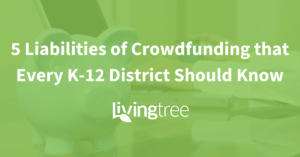Teacher crowdfunding can bring important resources – tied to specific classroom needs, where government funding falls short. But it also opens educators up to substantial liabilities. It’s crucial for school districts to understand how to manage the risks that are associated with crowdfunding campaigns.
Any time a school or educator starts a crowdfunding project, they open themselves up to substantial liabilities. With all of the potential risks that can result from these fundraising campaigns, it’s crucial for school districts to implement crowdfunding policies that will help protect them.
Teacher crowdfunding started as a way to help educators subsidize the average of $479 each spends on basic school supplies every year to make up for shortages in government funding.1 The activity now raises hundreds of millions of dollars for classrooms annually. The amount grows each year. What was a novelty is rapidly becoming the way web-savvy teachers do business.
Crowdfunding involves online platforms managed by for- and nonprofit organizations that connect teachers and potential private funders – individuals, companies and foundations. At its most basic, a teacher goes online to create a campaign page describing their need and the total amount of money required. Then, to reach potential funders the request is disseminated by email or social media. Funders go to the page and use a credit card to make their donation. The platform purchases the requested products or distributes the money.
Today, many crowdfunding sites serving educators have made efforts to put some basic safeguards in place, but they still remain insufficient. They require funds or products purchased with donations to be distributed to the school district and register each teacher’s campaign with the district. Districts can then adopt formal policies requiring teachers to use only sites approved by the district.
This approach to risk management was sufficient when teachers were focused on school supplies. But as they became aware of the amounts of money they could raise online, more teachers resorted to crowdfunding and many established truly ambitious campaigns to purchase computers, class trips, and curriculum-related materials and software. The expanding goals of these campaigns create more challenging risks to school districts and the volume of campaigns can overwhelm their business offices.
This point was underlined by the National School Boards Association’s Council of School Board Attorney’s review of one popular teacher crowdfunding site:
In summary, while many of the entries posted on the DonorsChoose.org site posed little to-no legal liability, there were an alarming number of entries that did pose some potentially significant issues, including a number of potential FERPA issues related to teacher-posted photographs combined with specific written information in the posts about the class, descriptions of would could legally be considered to be potential IDEA violations, and violations of specific district policies. Other posts, while they did not pose any particular legal liability, painted their schools and/or districts in a very negative light when asking for funds…2
Harford County Public Schools (HCPS) Superintendent Barbara Canavan’s explanation of her decision to ban crowdfunding offers a real-world example:
Canavan said she and her top aides stopped teachers from using Donors Choose and AdoptAClassroom because there are no controls in place to govern how the money comes to the schools, as it goes directly from the donors to the teacher, plus there are no controls on the materials obtained and whether items such as books are aligned with the HCPS curriculum…. The superintendent said photos of students and their classrooms have been posted online without being vetted through the safety and security division, and the school system’s name was placed on a donors’ list without permission.3
Canavan’s concerns include the lack of accountability as the money goes straight to teachers from the funding source and the lack of oversight of whether the materials purchased are appropriate expenditures and that they would be approved curriculum.4
Teacher crowdfunding can bring important resources – tied to specific classroom needs, where government funding falls short. But it cannot bypass district systems that assure accountability to donors, students, IDEA requirements, as well as state curriculum and standards requirements.
California School Boards Association Senior Policy Manual Consultant Diane Greene offers districts’ some guidance on how districts should approach a crowdfunding policy:
“Despite the obvious benefits of online fundraising, districts need to be aware of all such campaigns conducted in the name of the district, a district school or a district employee. It’s important that the district set ground rules that ensure transparency, fiscal integrity and effective use of the funds.”
…. In general, donations received through crowdfunding should be subject to the same conditions and criteria as donations received through other means. However, the unique nature of such platforms may raise additional considerations that should be addressed in district policy…. Given the widespread use of crowdfunding platforms by teachers for everything from classroom materials to field trips to furniture, there may be a misperception that staff is authorized to launch such campaigns at their discretion. It is the district’s responsibility to provide clear direction for any fundraising efforts that are linked to district programs.5
The criteria included in the crowdfunding rules adopted by New Prague Area Schools, Minnesota in March of 2019 cover most of the issues that districts must address to meet their legal obligations. Each criterion suggests considerations, processes, and decisions too complicated to describe here. Districts should consider them a starting point for devising a crowdfunding policy, rather than the last word.
• Proposals that support the curriculum must be standards-based.
• The proposal must not conflict with the current and/or planned curriculum and instruction activities set forth by the District.
• Proposals must support district priorities.
• Proposals may not request materials that could be substituted by similar materials that are already supplied by the District or could be supplied by the District.
• Proposals may not start a program that would require the continued use of materials or funding beyond what is obtained through the proposal.
• The proposal cannot result in demands on staff not involved in the proposal.
• The proposal cannot request athletic equipment in conflict with the athletic programs of the District.
• The proposal must not cast a negative light on the district or any of its programs or employees.
• Campaigns cannot benefit individuals.
• Proposals must follow District policy, including the Wellness Policy.
• Crowdfunding campaigns cannot be contingent on additional District spending or require matching funds from the District or other organization.
• Crowdfunding campaigns cannot contain language that suggests or states that an item for which the donations are being sought are required for or integral to a student’s special education program, necessary for a student to achieve their IEP goals, or necessary to ensure participation of a student of students with disabilities in school or any program offered by the District….
• Administrators will verify that statements regarding special education programs are consistent with Free Appropriate Public Education (FAPE), Individuals with Disabilities Act (IDEA), and Health Insurance Portability and Accountability Act (HIPPA).
• Under the Family Educational Rights and Privacy Act (FERPA), the publication of student images (or names) is not authorized except as to specified permitted categories of “directory information,” and even then for specific purposes. Even if directory information is used properly, parents have a right to opt their children out. ONLY PHOTOS OF UNIDENTIFIABLE CHILDREN (ex., the backs of heads) may be used on your crowdfunding application page.
• All items/materials obtained through District approved crowdfunding are the property of the District. While preference is given for the items/materials to be used and maintained by the employee who originally obtained them through crowdfunding, the District reserves the right to transfer such items/materials to another classroom and/or teacher, where necessary.
• The District will take into account the volume of requests as well as the above criteria and reserve the right to limit the number of requests approved.
In an ongoing effort to support school districts in their decisions around crowdfunding, Livingtree has provided this information to highlight the risks and liabilities that unregulated crowdfunding can pose. Particularly as more educators understand the potential of crowdfunding to support their students, and if the district is to consider the application of every teacher with an eye towards approving those that meet the criteria described above, it must have sophisticated support systems in place.
Livingtree is helping districts across the country support online fundraising in their schools by providing complete oversight and financial control through a fundraising management platform with processes that align with district policies. Livingtree has additional resources available for download, including published reports and examples of district policies.
By Dean Millot, Advisor for Livingtree, Inc.
1. The Average Teacher Spends $479 a Year on Classroom Supplies, National Data Show, Madeline Will, Education Week, May 15, 2018, https://www.edweek.org/ew/articles/2018/05/15/the-average-teacher-spends-479-a-year.html
2. Creative Revenue Streaming and Public Schools: A Legal Discussion Regarding Non-Traditional, New and Creative Revenue Streaming Trends in Public Schools Nationwide, Erin D. Gilsbach, King Spry Herman Freund & Faul, National School Boards Association Council of School Attorneys, 2016 https://cdn-les.nsba.org/s3fs-public/16-Gilsbach-Creative-Revenue-Streaming-Paper.pdf
3. Harford still opposes crowdfunding sites for school donations, The Aegis, August 18, 2017, 5:45 AM, https://www.baltimoresun.com/news/maryland/harford/aegis/ph-ag-school-supplies-0818-20170818- story.html 2/
4. Reason for caution on school crowdfunding, Editorial, Baltimore Sun, August 25, 2017 https://www.baltimoresun.com/news/maryland/harford/aegis/opinion/ph-ag-edit-schools-crowd-funding- rejected-0823-20170825-story.html
5. Online Fundraising Helps Schools, But Requires District Oversight, California School News, October 2018: news.csba.org/article/Online+Fundraising+Helps+Schools%2C+But+Requires+District+Oversight/3217000 /535490/article.html 1/





Pingback: How to Make Crowdfunding Work in Your School District (A Step-By-Step Guide) - Livingtree